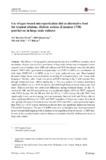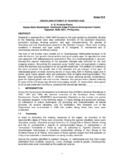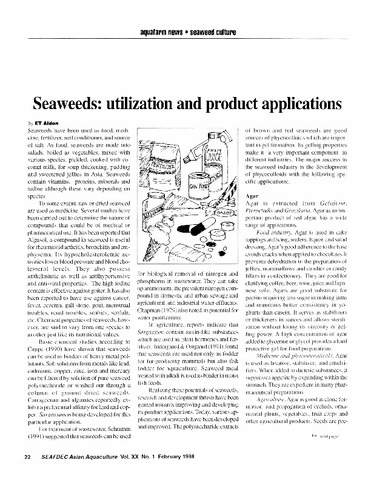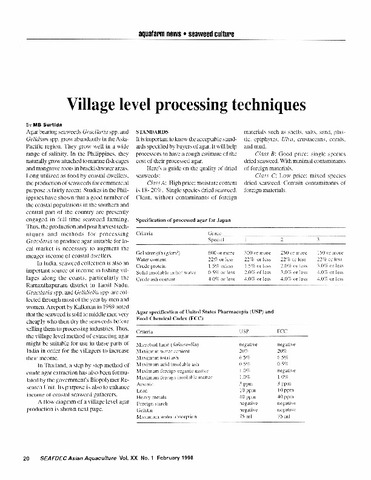Use of agar-bound microparticulate diet as alternative food for tropical abalone, Haliotis asinina (Linnaeus 1758) post-larvae in large-scale cultures

View/
Request this document
Date
2017Author
Page views
202Metadata
Show full item recordCited times in Scopus
Share
Abstract
The efficacy of using agar-bound microparticulate diet (A-MPD) as alternative food for abalone Haliotis asinina Linne post-larvae in large-scale culture was investigated. Larvae sourced from the hatchery-bred (HB) and wild-sourced (WS) broodstock were fed with either diatoms (TMT1-NF), agar-bound microparticulate diet (TMT2-A-MPD), or a combination of both feeds (TMT3-NF + A-MPD) in six 2-m3 tanks replicated over time. Three hundred thousand veliger larvae were stocked/tank containing 80 corrugated plates with mucus trails hanging on bamboo poles. Feeds were given at 0900 h starting at day 3 with seawater flow through introduced every 1400 h starting day 5. Two-way analysis of variance determined significant differences (p < 0.05) in survival and shell length between larval sources and feed types. Tukey’s post hoc test established differences among treatment means. At day 30, survival for HB- and WS-sourced larvae was significantly higher (42%) in TMT3 compared with TMT2 having 35% for HB and 38% for WS (p < 0.05). Larvae fed with TMT1 had significantly lowest survival among the three treatments. Survival at 60 and 90 days did not show significant difference for TMT2 and TMT3 regardless of broodstock source. Post-larval shell growth (90 days), from both sources fed with TMT2 and TMT3, was significantly higher than TMT1 (p < 0.05). Larval performance did not show any significant interactions between HB and WS broodstock. The use of A-MPD alone or in combination may elicit improvement in survival and shell length growth in abalone larvae regardless of larval sources. A-MPD may be used as full or partial replacements to diatoms as alternative food for abalone post-larvae in large-scale culture.
Suggested Citation
Bautista-Teruel, M. N., Maquirang, J. R. H., de la Peña, M. R., & Balinas, V. T. (2017). Use of agar-bound microparticulate diet as alternative food for tropical abalone, Haliotis asinina (Linnaeus 1758) post-larvae in large-scale cultures. Aquaculture International , 25(3), 1239-1252. https://doi.org/10.1007/s10499-017-0110-9
Subject
Collections
- AQD Journal Articles [1215]
Related items
Showing items related by title, author, creator and subject.
-
Gracilaria studies at SEAFDEC/AQD
Hurtado-Ponce, Anicia Q. (Network of Aquaculture Centres in Asia-Pacific, 1996)Research in seaweed from 1988–1994 focused on the agar producing Gracilaria. Studies in the following areas were also conducted: inventory of the seaweed resources; production ecology; farming systems; and agar characterisation. ... -
Seaweeds: Utilization and product applications
Aldon, E. T. (Aquaculture Department, Southeast Asian Fisheries Development Center, 1998)Seaweeds have been used as food, medicine, fertilizers, soil conditioner and source of salt. Realizing the potentials of seaweeds, research and development thrusts have been geared towards improving and developing its ... -
Village level processing techniques
Surtida, M. B. (Aquaculture Department, Southeast Asian Fisheries Development Center, 1998)The agar-bearing seaweeds Gracilaria and Gelidium grow abundantly in the Asia-Pacific region. Production and post-harvest techniques and methods for processing Gracilaria to produce agar suitable for local market is necessary ...




